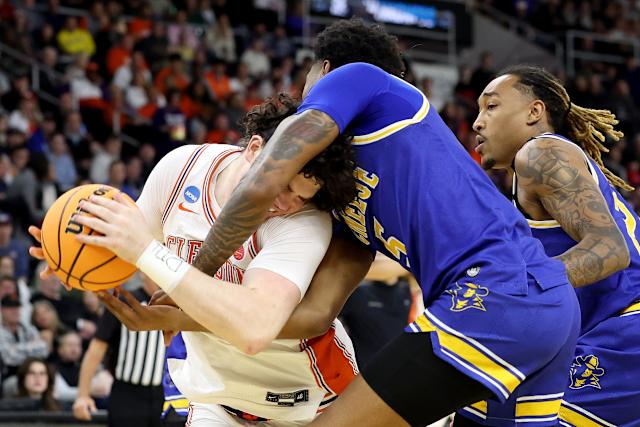March Madness 2025: No. 5 Clemson Narrowly Misses Tying Infamous NCAA Tournament Record in First Half vs. No. 12 McNeese
The opening round of the 2025 NCAA Tournament was full of surprises, but few were as shocking as the disastrous first half performance of No. 5 seed Clemson against No. 12 seed McNeese. The Tigers, who had entered the tournament with high hopes of making a deep run, found themselves in a hole so deep that they nearly tied an infamous NCAA Tournament record for futility. Despite being the higher-seeded team and having the talent advantage, Clemson’s opening-half struggles were unlike anything the program had witnessed in years. A combination of turnovers, poor shooting, and defensive breakdowns made for a chaotic and bewildering first 20 minutes of play.
As the game unfolded, it became clear that McNeese, the underdog, wasn’t going to just roll over. They fought tooth and nail, taking advantage of every mistake Clemson made, and by halftime, the Tigers were on the brink of a historic embarrassment. With the possibility of breaking a nearly 40-year-old NCAA record for the lowest halftime score looming large, Clemson’s fate hung in the balance.
In this article, we’ll break down what led to Clemson’s catastrophic first-half performance, analyze how they avoided tying the infamous NCAA tournament record, and look ahead to what went wrong and what could have been done differently.
A Disastrous Start: A Record-Breaking Collapse in the Making
From the very beginning of the game, it was evident that something was wrong with Clemson. The Tigers, who had dominated much of the regular season in the ACC, appeared out of sorts. Their offense was sluggish, their defense nonexistent, and their body language spoke volumes about the mounting frustration they were feeling.
In the opening minutes, McNeese made it clear that they were ready to play, and they weren’t going to be intimidated by their higher-seeded opponent. The Cowboys hit early shots and took control of the tempo, forcing Clemson into a position they hadn’t been in all season: playing catch-up. On offense, Clemson’s execution was horrendous. Star players who had been lights out during the regular season, including guard Chase Hunter and forward PJ Hall, couldn’t buy a basket. Clemson missed easy shots, missed free throws, and committed turnover after turnover.
To put the first half into perspective, by the 10-minute mark, Clemson had already committed seven turnovers—an unusually high number for a team known for its ball control. The Tigers’ offense was unable to find any rhythm, and as McNeese continued to exploit Clemson’s mistakes, the Tigers seemed to unravel further.
At the 15-minute mark, the score was already 18-7 in favor of McNeese, with Clemson struggling to make any significant offensive impact. The Tigers were forcing shots and rushing possessions, contributing to a growing sense of panic on the court. The Cowboys capitalized on every misstep, playing with a level of intensity and composure that belied their lower seed.
By the time the first half wound down, Clemson’s performance had reached disastrous proportions. They had scored only 15 points in the first 18 minutes of the half—an alarming stat for a team with the offensive firepower that Clemson boasted. But it wasn’t just the lack of scoring that was concerning. The Tigers were being outplayed in every facet of the game: they couldn’t secure rebounds, they couldn’t make open shots, and they were getting out-hustled by the Cowboys.
With just a few minutes remaining in the first half, Clemson was staring down the barrel of a potential historic collapse. The record they were in danger of breaking? The lowest halftime score in NCAA Tournament history, which stood at 16 points—set by the 1981 edition of Northern Kentucky in their opening-round loss. With Clemson sitting on 15 points, it was clear that unless they somehow turned things around in the final minutes, they might be in danger of making NCAA Tournament history for all the wrong reasons.
The Infamous Record: What Was at Stake?
Before diving into how Clemson avoided setting the record for the lowest halftime score, it’s worth revisiting the historical context of this infamous stat. The record for the fewest points in an NCAA Tournament first half was set by Northern Kentucky in 1981 during a match-up against LSU. Northern Kentucky’s offensive struggles that day resulted in just 16 points at halftime, a record that still stands as one of the low points in NCAA Tournament history.
In a tournament full of high-scoring games and dramatic finishes, being associated with a record like this would have been an incredibly embarrassing feat for any team, let alone a No. 5 seed like Clemson. The fact that they were on pace to tie this ignominious mark just added to the pressure mounting on the Tigers. As the game wore on, it seemed as though no amount of adjustment could break the Tigers free from their offensive malaise.
Clemson’s Close Call: A Narrow Escape from the Record
As the clock ticked down toward halftime, Clemson needed a spark—anything to prevent them from joining the ranks of those who had failed to score in the teens during a first half. Enter junior guard Chase Hunter. Hunter, who had been relatively quiet up until this point, hit a much-needed three-pointer with under a minute left in the half, bringing the Tigers’ total to 18 points—just shy of the Northern Kentucky record. That three-pointer gave Clemson some much-needed momentum heading into the break, preventing them from becoming the first team to tie the infamous record in over four decades.
Though the final score of 18 points at halftime was still dismal, the Tigers managed to avoid even more historical shame with that late shot. Still, the damage had already been done. At halftime, McNeese held a commanding 40-18 lead, leaving Clemson with a lot of work to do if they wanted to even have a shot at advancing past the first round.
Analyzing the Root Causes of Clemson’s Struggles
Several factors contributed to Clemson’s disastrous first-half performance. To fully understand what went wrong, it’s essential to look at both the team’s individual shortcomings and the broader issues that plagued them during those 20 minutes of basketball.
1. Turnovers and Poor Decision Making
Clemson’s ball security was the first major issue. The Tigers turned the ball over 11 times in the first half alone, a statistic that directly led to fast-break points for McNeese. The Tigers’ decision-making on offense was erratic; they rushed shots, forced passes into tight spaces, and failed to execute plays. This made them extremely vulnerable to McNeese’s fast-paced offense, which capitalized on Clemson’s mistakes.
2. Offensive Inefficiency
Clemson’s shooting in the first half was another major factor. The Tigers shot just 25% from the field and 12% from beyond the arc. The normally reliable Chase Hunter and PJ Hall, both capable of taking over games, were completely stifled by McNeese’s defense. Clemson’s offense lacked fluidity, and the team was unable to create open looks, resorting to desperate attempts as the half wore on.
3. Defensive Lapses
While Clemson’s offense was struggling, their defense was hardly better. McNeese took advantage of Clemson’s slow rotations, finding open shots and exploiting the Tigers’ inability to close out on shooters. The Cowboys were confident, and their ability to capitalize on defensive breakdowns kept Clemson on the ropes.
4. Psychological Pressure
Clemson’s performance was also mentally taxing. The Tigers appeared rattled by McNeese’s unexpected energy and focus. Their lack of poise, especially in critical moments, amplified their struggles. The longer the half dragged on with no sign of an offensive breakthrough, the more the team seemed to press, compounding their problems.
The Second Half: A Partial Recovery
Coming out of halftime, Clemson was still very much alive, though they had dug themselves a deep hole. The Tigers’ offense improved slightly in the second half, though they continued to struggle with shooting and turnovers. Ultimately, their efforts came too late to mount a full comeback.
Despite outscoring McNeese 39-35 in the second half, Clemson’s first-half deficit proved too much to overcome. They ended up losing the game 75-57, but it was the shocking first-half struggles that defined their March Madness campaign. While they managed to avoid the historical record for fewest first-half points, they could not shake the feeling that they had squandered a golden opportunity.
What’s Next for Clemson?
Clemson’s disastrous performance in the first half against McNeese leaves plenty of questions unanswered. The Tigers were clearly capable of playing much better than they showed in that opening 20 minutes, but they need to address some key areas in the offseason, including ball control, shooting efficiency, and mental toughness.
March Madness is a tournament of volatility, and the Tigers learned that even a No. 5 seed isn’t immune to the chaos. As they move forward, Clemson must use this defeat as a wake-up call to refocus and come back stronger in future tournaments.



